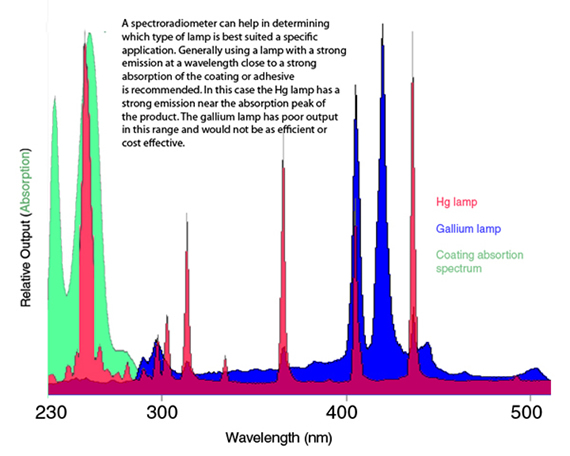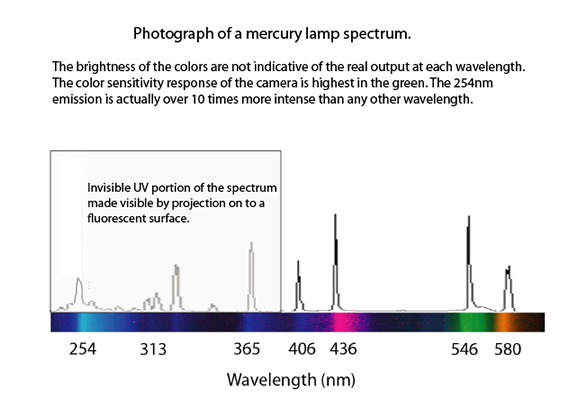Guide to UV Measurement
Spectroradiometers
A spectroradiometer is the ultimate narrow band radiometer - it can provide intensity values for very small bands of optical radiation being emitted from a source, reflected from a surface, or transmitted through a medium at every wavelength within its operating range.
Spectroradiometers are available with resolution that can measure to a few nanometers or even a fraction of a nanometer.
This is different from a radiometer, which measures the integrated values over a range (narrow or wide band based on the design) of wavelengths. The information from a spectroradiometer is usually presented in graphical form wherein the wavelengths covered are shown on the x-axis and the magnitude of the radiometric measurement is shown on the y-axis. The data from a radiometer is in the form of a single numeric value in the specified radiometric units.
In UV curing related applications, a spectroradiometer is primarily used to determine the spectral distribution of energy being emitted from a lamp. For polymerization and curing to take place, the formulation must be exposed to the proper distribution of UV energy.
Spectroradiometers allow:
- Researchers to determine which wavelengths are the most efficient and effective for an application or set of materials.
- Lamp manufacturers to evaluate and adjust the spectral output performance of their lamps. This can be used during R&D work and as a quality control tool to verify that the spectral distribution of the lamp is consistent from one lamp to the next (spectral-comparison).
- Users to check lamps as they age for spectral shifts and changes. The loss of power is not uniform at all wavelengths and even though a lamp's total output may decrease by 20%, it may be significantly lower at the critical wavelengths necessary to provide a successful cure.
- A spectroradiometer will help to evaluate the performance of the lamps and provide better discrimination in their evaluation than a single band pass radiometer.
A simple example of how a spectroradiometer works is to recall that white (visible) light going through a prism is spread out so that the eye can see all of the colors. In a spectroradiometer the prism is replaced by a diffraction grating, and a detector replaces the eye. The detector or detectors depending on the instrument design are sensitive to areas of electromagnetic radiation-UV, visible light, IR or a combination of all three. That detector(s) produces a current proportional to the intensity of the electromagnetic radiation hitting it. To prevent the detector from reacting to ambient room light, the grating and detector are enclosed in a light-tight box. The electromagnetic radiation (light) is collected by lenses, diffusers, or fiber optics and passes through the entrance slit, which is essentially a hole to let the electromagnetic radiation (light) in. The electromagnetic radiation (light) is spread out by the grating, and either strikes a series of detectors in a line, or is then allowed to pass through an exit slit to strike a single detector. In this case, the grating must be turned so that each wavelength passes through the slit and is individually measured. The first method is more rapid; however, the second method can provide finer differentiation of the wavelengths (resolution) and can see a larger portion of the spectrum.
Another advantage of a spectrograph is that it can replace a wide range of individual filters. A UVA filter allows wavelengths between 320nm and 380nm to pass and hit the detector. By adding up the intensities of every wavelength between 320nm and 380nm in the spectrum recorded by the spectroradiometer, the same results can be attained. A spectroradiometer can therefore replace UVA, UVB, and UVC filters as well as any narrow or wide band pass filter.
Most spectroradiometers use probes or fiber optic assemblies to pick-up and deliver the electromagnetic radiation to the diffraction grating. Like probes style radiometers, they usually measure the UV at point in space and not exactly at the cure surface. They are useful for looking at the changes in a system on a relative basis from their point in space. Many spectroradiometers have the ability to integrate the energy density values (J/cm²). Like probe style radiometers, many spectroradiometers do not go through the process in the same manner as the substrate. If you elect to integrate, the energy density value reported is not the same energy density value that the substrate would ‘see' on a moving line.



